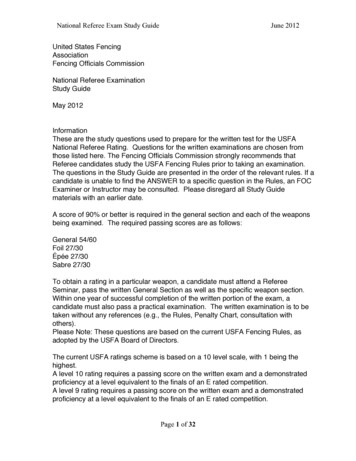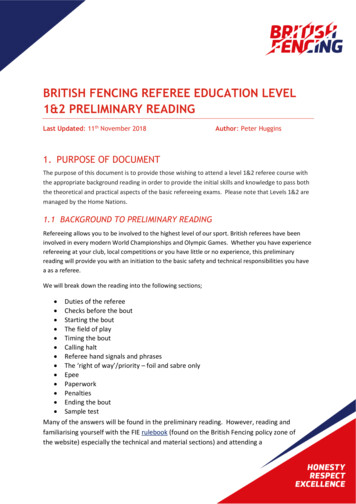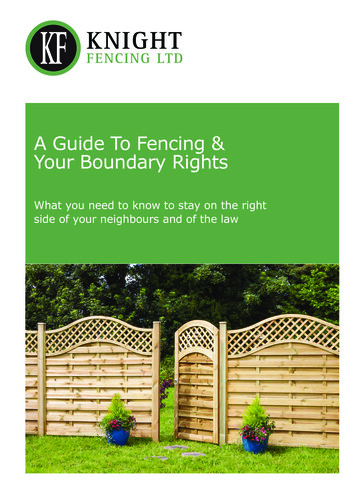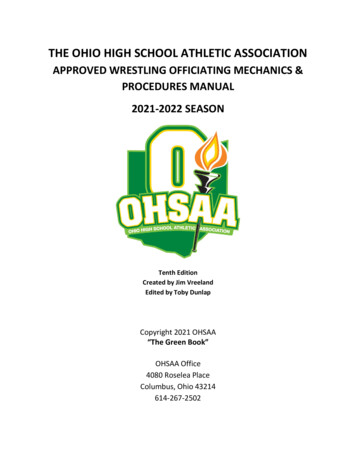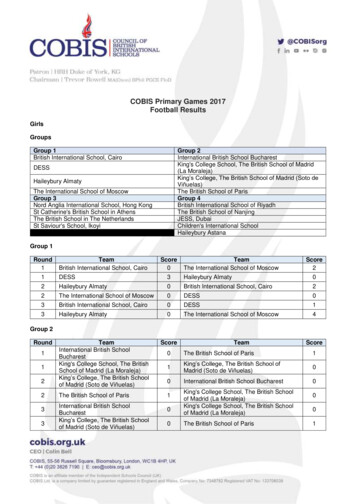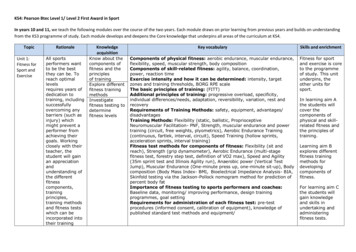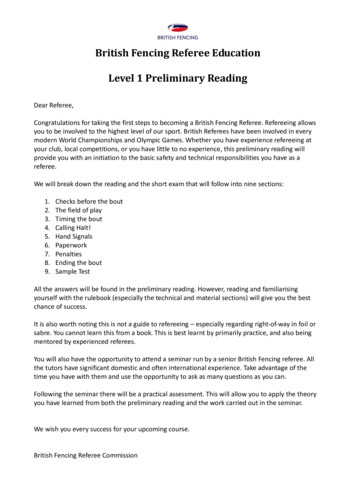
Transcription
British Fencing Referee EducationLevel 1 Preliminary ReadingDear Referee,Congratulations for taking the first steps to becoming a British Fencing Referee. Refereeing allowsyou to be involved to the highest level of our sport. British Referees have been involved in everymodern World Championships and Olympic Games. Whether you have experience refereeing atyour club, local competitions, or you have little to no experience, this preliminary reading willprovide you with an initiation to the basic safety and technical responsibilities you have as areferee.We will break down the reading and the short exam that will follow into nine sections:1.2.3.4.5.6.7.8.9.Checks before the boutThe field of playTiming the boutCalling Halt!Hand SignalsPaperworkPenaltiesEnding the boutSample TestAll the answers will be found in the preliminary reading. However, reading and familiarisingyourself with the rulebook (especially the technical and material sections) will give you the bestchance of success.It is also worth noting this is not a guide to refereeing – especially regarding right-of-way in foil orsabre. You cannot learn this from a book. This is best learnt by primarily practice, and also beingmentored by experienced referees.You will also have the opportunity to attend a seminar run by a senior British Fencing referee. Allthe tutors have significant domestic and often international experience. Take advantage of thetime you have with them and use the opportunity to ask as many questions as you can.Following the seminar there will be a practical assessment. This will allow you to apply the theoryyou have learned from both the preliminary reading and the work carried out in the seminar.We wish you every success for your upcoming course.British Fencing Referee Commission
1. Checks before the boutClothing checks All clothing, including the glove, must be in good condition without holes or tears.Minimum safety standards are determined by the type of competition Protection levels are either Level 1 (350N) or Level 2 (800N clothes, 1600N masks) – youshould check the requirements at the beginning of any competition. Pay particular attention to the under-plastron by checking the stamp on the front andthat it is worn correctly.Wearing the kit Jacket and breeches must overlap by at least 10cm when on guard and the shoulder bracesshould be worn correctly.All female fencers must wear a chest protector.At foil, all chest protectors must be underneath the under-plastron.At foil and sabre, the lamé jacket must cover the target area. In simple terms, it shouldcover at least until the top of the hips in foil, the entire shoulder in foil and to the top of thecrease of the thigh and groin at sabre. The wire should be clipped on the sword arm side ofthe lame to prevent tampering. Masks must be free of dents and soft spots, all seams must be intact, and a back strapfitted. Body wires and mask clips must be clipped on correctly and have no large loopsof wire hanging loose. Visor masks are a special case. Only visors with two layers (currently only Leon Paul) arepermitted at foil or epee. In all weapons the visor must be less than two years old,indicated by a date engraving.Blade and Point Checks Epée Blade must be bent no more than than 1cm, in the vertical plane (either up or down). Check that the barrel is fixed and doesn't unscrew. Check that the tip has both grub screws. Screwless or plastic tips are currently notallowed. Make sure the 1.5mm gauge fits between the tip and the barrel. Insert a 0.5mm gauge between the tip and the barrel and then depress the tip to testthe travel (it should not register a hit). Point spring must push up a 750g weight. A security device for the body wire must be inside the guard and at the spool end. Youcan use tape if this is missing.Foil Blade must be bent no more than than 1cm, in the vertical plane (up or down). The top 15cm of the blade from the bottom of the tip must be insulated (usually withtape). Point spring must push up a 500g weight.Sabre Blade must be bent less than 4cm, in the horizontal plane (left or right).
2. The field of playSize of the piste A piste is 14m long and between 1.5m to 2m wide.The piste must have a run-off at each end of 1.5 to 2m.If any part of a fencer's foot is on a line then the foot is on the piste. The entire foot must completely leave the piste.It helps to consider the piste to be a volume: The boundaries extend vertically upwards. A fencer can be on the piste even if a foot is raised.Crossing the boundaries When a fencer crosses a boundary with one or both feet you must call 'Halt!' Any hit made by an action that started after a fencer has left the piste is annulled. Any hit made by a single action that started before a fencer has left the piste with onefoot is valid. Any hit that lands after a fencer has left the piste with both feet, even where the actionstarted before the fencer left the piste, is annulled. An immediate action made by the fencer who has not left the piste (even if it is madeafter their opponent has left the piste) is valid. If a fencer leaves the piste, and no hits are scored, the fencer is penalised by the loss of ametre of ground from where they were when they left the piste. Correct on-guard distance is when, if both arms are extended, there is no overlap ofthe weapons. This may result in a fencer being pushed over the back line. If a fencer crosses the rear limit of the piste with both feet, either from the imposition ofthe above penalty or in the course of a fencing phrase, a hit is scored against them. Despite a hit being scored against them, it is not a cardable offence. It is the award of a penalty hit for crossing the rear limit of the piste. If a fencer leaves the piste through no fault of their own, e.g. being pushed due tocorps-à-corps, then there is no penalty.Your tutor will demonstrate these situations.
3. Timing the fightKeeping time may seem easy. .but it is absolutely vital to get it right every single time. Even if you have time-keepers, YOU are ultimately responsible. Especially using a box without a remote control, this can require you to make very closecalls as time expires, as many fights are won or lost in the closing seconds or as a resultof time expiring. If the clock fails, you have to estimate how much time is left and tell the fencers.The basic rules A hit may not be scored after time has expired, even if the action started before.If the scores are tied at the end of normal time the fencers fence for a deciding hit, with amaximum time limit of one minute.Before extra time starts the referee draws lots (coin toss / box random lights) to decide whowill win if no hit is scored in the extra minute.A fencer may not stop the bout to ask how much time is left, but they can ask when thebout is interrupted for some other reason.4. Calling “Halt!” The Referee calls “Halt!” at: The end of time. If a fencer leaves the piste (as covered in the previous section). If there are any safety issues, hits or penalties that need awarding. One common reason for calling halt is corps-à-corps. Corps-à-corps is any body contact between the two fencers. If a fencer is subject to corps-à-corps then the referee calls halt in all threeweapons, and cards the fencer(s) at fault in foil and sabre. The fencer then holds their ground, the offending fencer must give distance. However, this situation cannot force a fencer beyond their back line. Only a distance penalty for leaving the piste can result in a penalty hit.
6. Paperwork It may seem obvious, but it is absolutely crucial that you record the outcome of a boutcorrectly on the score sheet.You must follow the bout sequence, record the final score and any penalties awarded.Bout sequence A pool sheet will have the order of bouts show on it in two or three columns of figures suchas 1v2, 4v5, 2v3. These are read vertically so that you complete the first column beforestarting the second. An example is on the next page.The bout scores are written in the part of a pool sheet in the grid with the fencers’ names,two series of numbers, and a set of blank squares.Recording penalties: On each score sheet there should be a blank area below the results grid and the order ofbouts. It is in this area that you record the details of every penalty that you award.For each penalty you must record the bout in which it occurred, the name of the fencerpenalised and the group of the offence (the colour of the card awarded).You do not need to record the precise offence, although you can if you wish. It is important that you do note penalties on the score sheet. If you don’t write it down - it never happened. For example, if (in foil) you penalise a fencer for covering and award a yellow card, butfail to write this on the score sheet, and later in the bout the fencer again covers andyou award a red card; the fencer could appeal against the imposition of a red cardbecause this was his first Group 1 offence. By failing to write the first penalty down onthe sheet you will have denied the fencer’s opponent a hit. To save time, this can be recorded in a form of shorthand.Black card protocol If you award a black card you must make a more detailed note on the sheet. Write downthe full name of the person penalised and a brief description of what happened.When you get a break in the fencing you must prepare a full report of the incident,together with any ensuing aftermath, for the competition organisers to forward to BritishFencing’s Disciplinary Committee.
8. Ending the bout The fencers must: Return to the on guard lines. Salute their opponent, the referee and the audience.Referee must indicate the winner of the fight (see hand signals).Fencers then shake hands with each other.The match is not complete until this is all done.
referee. We will break down the reading and the short exam that will follow into nine sections: 1. Checks before the bout 2. The field of play 3. Timing the bout 4. Calling Halt! 5. Hand Signals 6. Paperwork 7. Penalties 8. Ending the bout 9. Sample Test All the answers will be found in the preliminary reading. However, reading and familiarising

